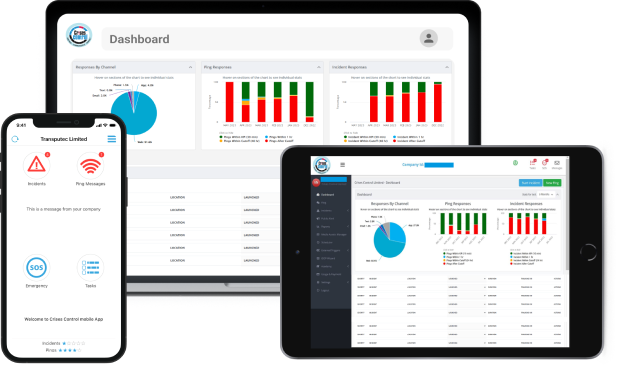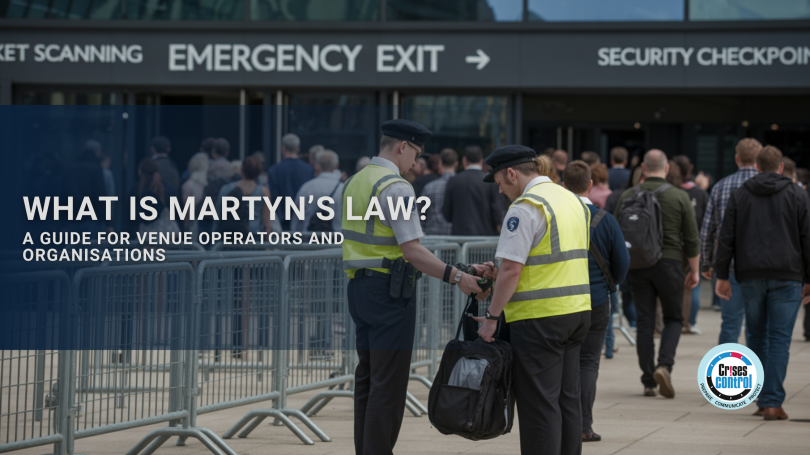Written by Anneri Fourie | Crises Control Executive
Why Martyn’s Law Matters: The Problem and the Solution
In 2017, the Manchester Arena attack left 22 people dead and hundreds injured. It wasn’t just the brutality of the act that shocked the nation, but also how unprepared the venue was to handle it. There was no clear plan. No tested system to communicate with staff. No specific measures in place to protect those inside.
The government recognised this failure. The result is Martyn’s Law, also referred to as the Protect Duty. It aims to make sure public spaces and venues do more to protect people from acts of terrorism. But many organisations still don’t know what it means for them, when it’s coming, or how to prepare.
This guide breaks it down in plain English. We’ll explain what Martyn’s Law is, who it affects, what you’ll need to do to comply, and how tools like Crises Control can help you meet the requirements.
What Is Martyn’s Law?
Martyn’s Law is proposed UK legislation that will require certain venues and organisations to improve their security planning to better protect the public from terrorist attacks.
Named after Martyn Hett, who was killed in the Manchester Arena bombing, the law was driven by his mother, Figen Murray, who has campaigned tirelessly for change. The law is expected to be introduced in stages, with the final version due to be passed in the near future.
- It focuses on making sure venues take practical steps to:
- Understand the risk of a terrorist attack
- Prepare staff with training and drills
- Put plans in place to deal with a live incident
This is not just about checking boxes. It’s about being genuinely prepared. Having a plan isn’t a luxury anymore. It’s a responsibility.
Who Does Martyn’s Law Apply To?
If you run a location that the public can access, Martyn’s Law will likely apply to you.
The legislation splits venues into two tiers based on their size:
Standard Tier: 100 or more capacity
If your venue can hold 100 people or more, you will need to:
- Conduct a basic terrorism risk assessment
- Train staff on recognising suspicious behaviour and knowing what to do in an emergency
- Develop and keep a simple emergency plan
This applies to places like cafes, bars, shops, galleries, and community centres.
Enhanced Tier: 800 or more capacity
If your venue can hold 800 people or more, you will need to meet more detailed requirements:
- Carry out thorough risk assessments
- Create formal security plans
- Put systems in place for emergency communications
- Register your venue with a relevant authority
- Test and update plans regularly
This could include concert venues, large sporting arenas, universities, hospitals, and major transport hubs.
Even if you fall below these thresholds, it still makes sense to look at your preparedness. Terrorism isn’t limited to big venues. Any public space could be at risk.
What Are the Core Requirements?
Martyn’s Law is designed to make sure venues have the tools and training to respond quickly and effectively. Here are the main areas of focus:
1. Assess the Risk
You need to look at your venue and consider how it might be vulnerable to an attack. Think about:
- Entry and exit points
- Large gathering areas
- Security procedures
- Response times
This isn’t a standard fire risk assessment. It’s specific to the risk of terrorism, which can take many forms, from knife attacks to vehicle use.
2. Train Your Staff
Everyone working at the venue should understand what signs to look out for and what to do in the event of an emergency. Training should cover:
- Spotting suspicious behaviour
- Recognising unattended items
- Following lockdown, evacuation, and shelter-in-place instructions
Regular training refreshers are recommended so that procedures stay top of mind.
3. Create an Emergency Plan
Every organisation needs a clear and tested plan. This should include:
- What to do if an attack occurs
- Who takes responsibility for key actions
- How to contact emergency services
- How to communicate with staff and the public
Plans should be written in plain language and tested regularly with live drills.
4. Test and Review
It’s not enough to create a plan and file it away. The law expects you to regularly review and test it. This can be through table-top exercises or full-scale simulations.
You also need to update your plans when:
- Layouts change
- New risks emerge
- You take on new responsibilities
When Will Martyn’s Law Come into Force?
The government has committed to introducing Martyn’s Law, and the legislation is moving through its final consultation and review phases. A full version of the law is expected to be passed soon, followed by a grace period to allow organisations time to prepare.
Even before it becomes law, public and private sector organisations are being encouraged to start preparations now. Doing so not only shows responsibility but may also protect you legally and reputationally in the event of an incident.
Common Questions About Martyn’s Law
1. What types of places will need to comply?
Publicly accessible locations (PALs) like shopping centres, cinemas, music venues, leisure facilities, local government offices, and places of worship are included.
2. Will smaller venues need to hire full-time security?
No. The law is designed to be proportionate. If you’re a small business or community space, your responsibilities will be lighter, such as a simple plan and basic staff training.
3. What happens if we don’t comply?
While the final penalties are still being defined, it’s likely there will be civil sanctions, potential legal action, and reputational damage if you fail to meet your responsibilities.
How Crises Control Supports Martyn’s Law Compliance
Crises Control is a platform that helps organisations prepare for, respond to, and recover from incidents. It’s not just for major disasters. It’s designed to be practical, usable, and valuable even for smaller venues.
Here’s how it can help with Martyn’s Law:
Keep Your Risk Assessments Up to Date
You can store and manage digital risk assessments for all your locations. These can be updated quickly when risks change, and shared securely with relevant staff or authorities.
Train and Track Staff Readiness
Upload training content and track completion rates across your teams. This way, you have a clear record of who’s prepared and who needs further support.
Respond Faster in an Emergency
With Crises Control, you can send instant alerts to staff, contractors, or first responders via multiple channels: app notifications, SMS, voice calls, and email. That saves valuable minutes when every second counts.
Run Drills and Capture Learnings
Simulate incidents and monitor how well your team responds. All activity is logged automatically, giving you a full record for audits or reviews.
Take Control from Anywhere
Use the platform to manage your incident plans, assign roles, and make decisions in real time. All from a single dashboard on desktop or mobile.
What You Should Do Next
Martyn’s Law is not just about new rules. It’s about taking action that could save lives.
If you manage a public space or venue, start now:
- Review your risk exposure
- Build or update your response plan
- Talk to your staff
- Run a drill
- Look into tools that can support you, like Crises Control
By acting early, you’ll reduce your risk, protect your people, and make compliance much easier when the law takes effect.
Book a Free Demo
Crises Control is helping organisations like yours get ready for Martyn’s Law. Whether you’re starting from scratch or updating existing plans, we can support you at every stage.
Contact us now to arrange a free demo. We’ll show you how Crises Control makes compliance easier, planning more effective, and emergency response faster.
Request a FREE Demo

